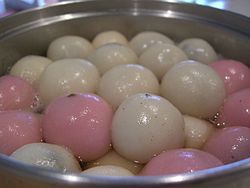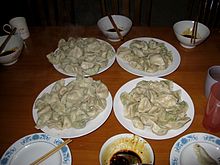
Back Dĕ̤ng-cáik CDO جشن دونگژی Persian Solstice d'hiver (fête chinoise) French Tûng-chiet HAK Tungcse-fesztivál Hungarian Dongzhi ID Festa di Dongzhi Italian Dongdži festivalis Lithuanian Pesta Dongzhi Malay Winterfeest Dutch
| Dongzhi Festival | |
|---|---|
 Tangyuan, a traditional Dongzhi Festival food | |
| Observed by | Chinese people |
| Type | Cultural |
| Significance | Marks the winter solstice |
| Observances | making and eating of tangyuan, ancestor worship |
| Date | December solstice (between December 21 and December 23) |
| Frequency | annual |
| Related to | Winter solstice |
| Dongzhi Festival | |||||||||||||||||||||||||
|---|---|---|---|---|---|---|---|---|---|---|---|---|---|---|---|---|---|---|---|---|---|---|---|---|---|
| Chinese | 冬至 | ||||||||||||||||||||||||
| Literal meaning | winter's extreme (i.e. winter solstice) | ||||||||||||||||||||||||
| |||||||||||||||||||||||||
| Alternative Chinese name | |||||||||||||||||||||||||
| Traditional Chinese | 冬節 | ||||||||||||||||||||||||
| Simplified Chinese | 冬节 | ||||||||||||||||||||||||
| Literal meaning | winter festival | ||||||||||||||||||||||||
| |||||||||||||||||||||||||

The Dongzhi Festival or Winter Solstice Festival (Chinese: 冬至; pinyin: Dōngzhì; lit. 'winter's extreme') is a traditional Chinese festival celebrated during the Dongzhi solar term (winter solstice), which falls between December 21 and December 23.[1][2]
The origins of this festival can be traced back to the yin and yang philosophy of balance and harmony in the cosmos.[3] After this celebration, it is believed that days will have longer daylight hours and therefore create an increase in positive energy flowing in. The philosophical significance of this is symbolized by the I Ching hexagram fu (Chinese: 復, "Returning").
- ^ "Traditional Chinese Festivals". china.org.cn. 2007-12-29. Retrieved 2022-08-20.
- ^ Aksjeselskap, Time and Date (2016). "Dōngzhì Festival in Taiwan". timeanddate.com. Time and Date AS.
- ^ Linda Sigurðardóttir, Dongzhi-Celebrating the Winter Solstice, GBTimes (Dec. 21, 2012) https://gbtimes.com/dongzhi-festival-celebrates-winter-solstice Archived 2018-08-15 at the Wayback Machine